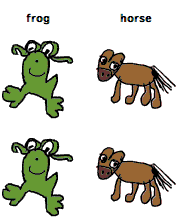Ever notice that sometimes a dog will say, “ouah ouah” instead of, “Woof Woof?” For whatever reason, we teach children animal sounds, and for whatever reason, children love looking at photos of animals and making silly noises.
In the video above you see that different languages interpret the language of dogs quite differently, but cats a cat’s meow is pretty much the Lengua Franca of the world. What’s even stranger, is that if you listen to a dog from Mongolia, it sounds just like a dog from Ohio…
Research
Well, I’ve done some research. According to Geoffrey Barto’s article on the topic, Languages are just as much about hearing as they are about speaking. A language is a set of syllables, or word parts, that we mix up in different ways to create different words. That make us used to both saying and hearing certain combinations of syllables.
This is why it’s hard to learn to understand a new language. You may know the grammar, the syntax, the vocabulary. But the sounds are another story. The language may have sounds that to you are identical but within it are completely different. Or it may not distinguish between sounds that to you are completely separate. Read more of Geoffrey’s Article
Early Start to Language
Pretty interesting. The language you speak affects the sounds you are able to perceive and distinguish from one another. But that isn’t something we learn when we are babies, it’s something we learn before we’re even born. The University of Wurzburg in Germany did a study a few years ago that analyzed the crying patterns of new born babies from Germany and France and found that the “melody” or pattern of rising and falling notes is not only different from their neighbors, but is similar to the natural “melody” of their parent’s speech paterns which is influenced by the language they speak.
The finding suggests that newborns just a few days old may already be trying to imitate the prevailing intonation patterns of the language they heard while still in the womb.
“I think we should be more aware that crying is a language itself,” she says, “and the baby is really trying to communicate with us by its first sounds already.”Read More
The Quack Project
Finally, the Quack Project is a project by researchers at Middlesex University in the UK to catalog the sounds that people attribute to animals in different languages and cultures around the world. They have a great graphical table of animals. Click an animal to hear children from different cultures demonstrating the animal sound.
Links in this Post
- Geoffrey Barto’s Article on animal sounds
- NPR: Babies May Pick Up Language Cues In Womb
- Quack Project
- Table of Global Comon Animal Noises in different languages
-Mike








Add comment